| ||||||||||||||||||
| ||||||||||||||||||
| ||
| Satellite image courtesy Jacques Descloitres, MODIS Land Rapid Response Team, NASA/GSFC. Taken April 8, 2004. | ||
Two and a half weeks off from work... check
Plane tickets... check
Two week supply of seasickness medicine... check
Satellite phone... check
Quest for adventure... check
... and so begins another one of my crazy vacations to fascinating and desolate corners of the globe. My goal is to observe a total solar eclipse in the middle of the ocean. This area happens to be ground zero for El Niņo. The nearest land will be 900 miles (1500 km) away, and even that is just an uninhabited French coral atoll off the Mexican coast, named Clipperton Island. The journey is most of the fun, so I'll be going through Ecuador and touring the Galapagos Islands before heading out to sea for the eclipse. I won't be doing this alone, the trip was arranged by Astronomical Tours and a hundred or so friends will be along.
|
My previous trips to see eclipses are listed here. What is a total solar eclipse? Well, through an amazing coincidence in geometry, every few years the Moon blocks out the Sun creating a solar eclipse. The Sun is 400 times the size of the Moon, and 400 times as distant, so they appear to be the same size when viewed from Earth. When the orbit of the Moon takes it between the Sun and the Earth, the shadow of the Moon is cast upon the Earth. If the Moon is close enough to the Earth, someone located near the middle of that shadow will see the Moon exactly block out the Sun in a spectacular show. This is a "Total Solar Eclipse", arguably the most spectacular show in astronomy. This particular eclipse is a special version, called an Annular-Total or Hybrid solar eclipse, because the Moon is just barely close enough to create a total eclipse in the Pacific. Because of the curvature of the Earth, people near the beginning of the eclipse track (off New Zealand) or the end (Panama) are too far away to get a total and they'll see an annular eclipse.
Here is my 78 page report, containing about 420 photos from the trip in Adobe PDF format. This is my definitive report, with better photos and more explanations than the simple daily updates below. Choose a version:
If possible, I will upload a picture or two and a short description during each day of the trip. Scroll down to the latest. I will NOT be checking email during the trip, please hold your questions until April 17th.
Today I flew from San Diego, California to Quito, Ecuador. I had to change planes in Houston, Texas. Quite a few members of our tour group were on the flight down to Quito, including several friends from prevous eclipse trips. It was great to see them again, and to meet some new folks.
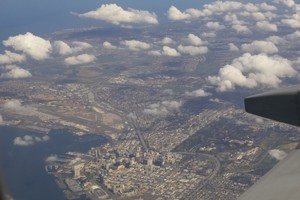 I got a great view of downtown San Diego after takeoff. |  We took a 737-700 from Houston to Quito. |
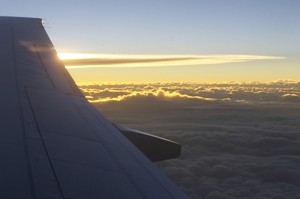 Sunset 39,000 feet over the Yucatan Peninsula. |
The morning was organized chaos as the 90 or so tour members had to check out of the hotel and be bussed to the Quito Airport. We gave up on trying to find our assigned seats on the old AeroGal 727 jet. After arriving in the Galapagos Islands and paying the park entrance fees, we had to take small zodiacs out to our ship, the Galapagos Legend. I'm sharing a cabin with Olivier 'Klipsi' Staiger.
The long day wasn't over. The ship sailed to Bartolome Island, where in the afternoon we went hiking and (some folks) went snorkeling. We saw amazing volcanic craters and a surprising assortment of wildlife. Swaths of volcanic moonscape are broken only by small tufts of gray plants and an occasional lizard. Crusted volcanic cones of wide-ranging sizes abut small lava tubes. The island is mostly brown, but with a stark grove of green bushes that seems completely out of place. I instantly recognized the view from the peak of the island, as shots from there were used in the Master and Commander movie.
It's great to be among fellow amateur astronomers, both longtime and newly made friends. We are getting to know each other and having a great time swapping stories of past trips.
Unfortunately, I learned that Canon's claims of the 1D Mark II digital camera being water resistant are pure lies. A wave kissed a small corner of my camera and completely killed the camera and attached 17-40mm F4L lens. I may try them again after they've had a few days to dry out, but for now it appears that I'll have to rely on my backup D60 camera and do without wide angle views. Insurance will replace the camera, but the loss of potential photos a big blow, especially on just the first real day of the trip!
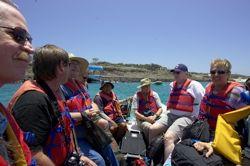 We had to take small zodiacs out to the ship. | 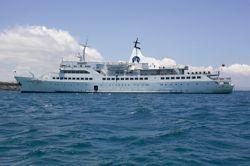 The Galapagos Legend, home for the next 15 days. |
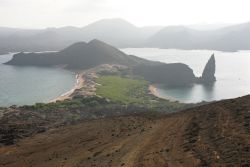 The view from the peak of Bartolome Island. (Seen in the Master and Commander movie). | 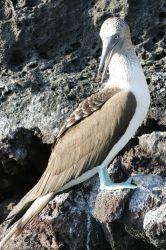 Blue Footed Booby. |
A meeting was held among the group leaders where we made some decisions about the eclipse chase. We'll arrive at the view site about 18 hours early, after sailing continuously for three days 19 hours. We've decided to keep EST (UTC-5), and to NOT observe daylight savings time. How often does one get the opportunity to decide what the clock should say?! However, this will significantly change the sunrise and sunset times as we go west.
Last night quite a few members of the trip went stargazing. The Captain obiligingly turned of all of the lights on the upper deck of the ship, so we had a prime dark sky observing session. Tonight it was cloudier until about midnight.
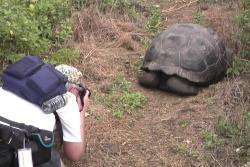 Fred Espenak photographs a small (300 kilo) giant tortoise. | 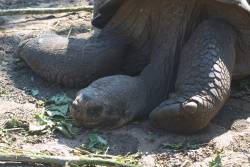 One of the larger tortoises. |
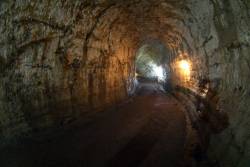 20 foot tall lava tube. | 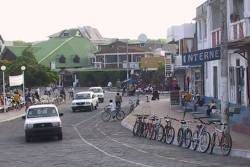 The main town on the island is Puerto Ayora, where we went shopping. |
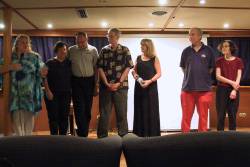 special guests. Left to right: Jen Winter, Wendee and David Levy, Fred Espenak and Pat Totten, Jay and Naomi Pasachoff. Dave Eicher not shown. |
In the afternoon we sailed to Isabela Island, the largest island. It's a collection of large volcanoes, and we hiked to Darwin Bay, a crater with ultrasaline water. Along the way we saw several of the types of finches Darwin studied.
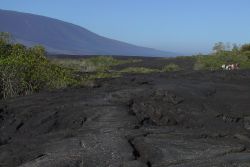 Fernandina's volcano last erupted in 1995.
| 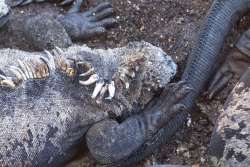 Marine iguanas are ghastly looking reptiles, nearly a meter long. |
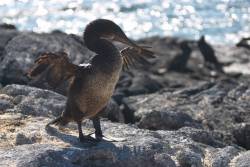 Flightless cormorant, note the small wings.
| 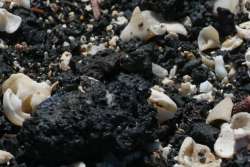 What appears to be gray sand is actally a collection of ground up lava and pulverized shells and bone. |
In the afternoon we visited Moreno Point, also on Isabela Island. This area is covered in sharp fragile lava, with half-acre lagoons of water and fields of grass inexplicably dotted though the landscape. We saw four flamingoes, a variety of other birds, a white tipped shark, and Galapagos penguins. Near the end of the hike, in a vast field of lava, I saw a spectacular panorama of five massive volcanoes spaced all around me. It was breathtaking, I had to stop and let the view soak in for a few minutes.
Weather forecasts for eclipse day are looking good, maybe a few puffy clouds (just enough to make for good pictures).
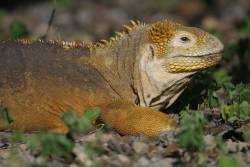 Land iguana, about three feet long. | 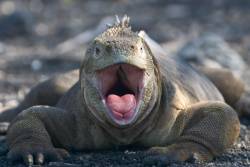 Say ahh! |
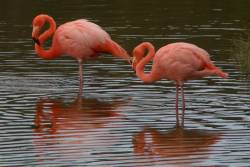 Flamingoes |  White tipped shark, about four feet long. |
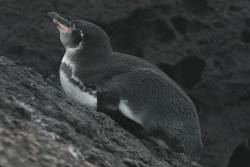 Penguin |
Today was a bit of a rest day after the hectic shore visits. Breakfast at 9. We staked out our observing positions for the eclipse and cleared them with Jen Winter. I'll be in a corner on the upper deck overlooking the pool deck.
I saw a school of small flying fish. In the evening we saw the zodiacal light a clear as day. The only light pollution out here is what we bring with us.
Weather forecast for eclipse day looks better than it did yesterday - very good instead of just good.
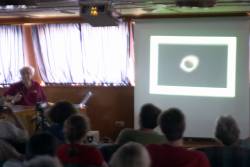 Jay Pasachoff giving a talk. | 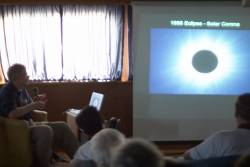 Fred Espenak giving a talk. |
We continue to see schools of dozens of flying fish. They are about a foot long and can fly up to 100-200 feet. The pop up aside and ahead of the ship and fly away from it in synchronized swarms. They're not simply jumping, I have seen them navigate around waves to maximize their range. We have also seen two whales, both very distant. I personally did not see the whales.
Two nights ago was the last time we saw another ship. During a tour of the ship's bridge, our captain told me that it was a cargo ship hauling fruit from Chile to Los Angeles, he had a nice chat with them on the radio. Nothing else is nearby, we are alone out here. I don't even recall seeing any aircraft. On the plus side, light pollution is nonexistent and the zodiacal light is as bright as the Milky Way. All of us amateur astronomers are having a blast. A side effect of the wonderful night skies is that the crew is getting fatter... According to the Captain everyone is sleeping in late and skipping breakfast, so the crew is enjoying the leftover breakfast food!
Eclipse preparations are in high gear. Vic & Jen helped make solar filters for the 25 or so people who needed them. Fred Espenak gave a talk on the vital statistics of the eclipse, including the Moon's irregular shape and what we should look for.
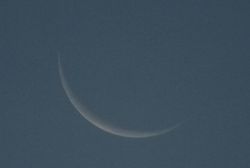 Predawn crescent Moon. | 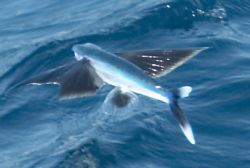 Flying fish, with bad fin (wing?). |
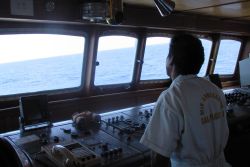 Bridge of the ship. | 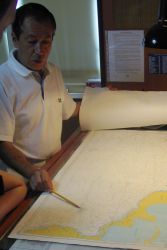 Captain explains the water currents. |
I'm getting nervous about the weather, it looks like it will be a close call, possibly with clouds at the start of the eclipse and clearing in time for totality.
The morning started with rain and much nail biting. With a ship we have the luxury of picking any nearby point to see the eclipse. It also means we have the duty to find the BEST point. Forecasts that had been predicting spectacular skies during the past week were revised to progressively worse outlooks after a massive band of clouds decided to jump in front of us. As the sole person on the ship capable of obtaining high quality weather information, it was up to me (Fred Bruenjes) to download and interpret the satellite images and computer model outputs that would indicate where to find clear skies at eclipse time. In the days just before the eclipse, that meant pulling new data every three hours and continually reassessing our aim point. Meteorology is one of my interests so I enjoyed the task.
We originally targeted 110 degrees west, but several days ago had revised that to 109 west to put more space between us and predicted clouds. As eclipse day neared, it became clear that even 109 west was not going to work. We had two options: head northeast and try to outrun the clouds, or head southwest and speed their passage. On eclipse morning it was heavily overcast and raining. It was too late to head northeast (the ship is slow and would not outrun the clouds), so we (myself, Jen Winter, Fred Espenak, and Olivier 'Klipsi' Staiger) decided to head southwest with no particular aim point. This meant sailing perpendicular to the swells, which would cause the boat to roll side to side up to 30 degrees, so Jen gave a PA announcement for people to batten down. I sat down to breakfast and had to hold my food in front of me.
At 11 AM, I downloaded the latest satellite image from under the cover of my jacket because it was raining. Not a good sign on an eclipse morning. The computer models were now predicting that the clouds would burn off and the remaining crud would push past us in time for the eclipse, and I could actually see the hole in the clouds coming on the satellite image. Would it get here in time? The group leaders and myself agreed that we should push as far south as possible to try and reach the clearing before the eclipse. Here's a GPS track showing our inital forays, trial runs, and ultimate postion:
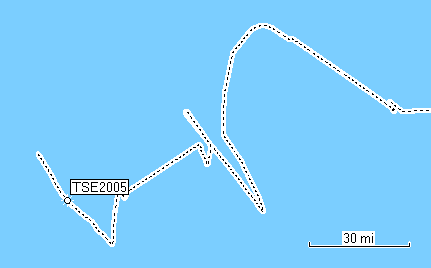
As the day progressed, it seemed hopeless. There were multiple cloud layers, occasional rain, and no signs of improvement. I tried to remain outwardly optimistic but inside I was getting nervous and the people who knew me well enough could tell. If those clouds were to clear they had better start moving... and they weren't moving!
As time ticked down towards the start of the eclipse, we finally got some signs that the computer predictions were coming to fruition. "Sucker holes" opened in the clouds and we saw flashes of blue sky. The burnoff of the upper cloud layer had started. Now we just needed the low stuff to blow out of here. Still moving southwest, Fred Espenak supplied eclipse coordinates and the 109° 30' West intercept was selected.
First contact (when the Moon first touches the Sun) came on time and provided confirmation that we were at the right place. Clouds were still covering the sky, but were thin enough and had some breaks that provided satisfactory viewing. Things were looking up!
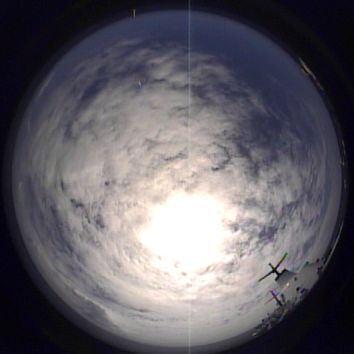
I (and everyone else on board) set up equipment and prepared for the main event: Totality, when the Moon completely covers the Sun and turns day into night. About 15 minutes to totality, it looked like we would still be covered in clouds, while a nearby area would be clear. Some of us contemplated ordering the ship to steam for the clear area at maximum speed, but it was decided to press on and view the eclipse from here clouds or not.
In a near miracle, seven minutes before totality the last of the cloud layers cruised past us, heading northwest (as predicted but running a little late). Hooray! The sky was clearing at an astounding pace and we were assured of our view of totality.
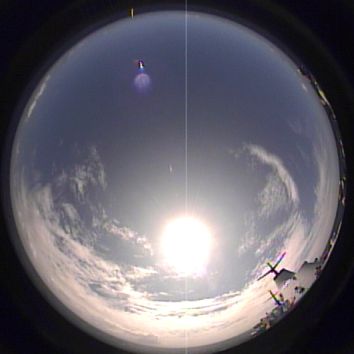
7 minutes before totality... clear view!
David Levy provided commentary via a microphone and directed us to look for shadow bands, Venus, the corona, and other sights before the eclipse. Shouts of joy from all of the passengers began to drown out all other noises.
The Moon's shadow was seen as a darkening in the southwest and all of a sudden it was upon us. The Sun faded to near nothingness behind the Moon. With my 15x50 binoculars the view was simply glorious. The sky was bright from the unusually narrow shadow, and so the corona (wispy manifestation of the solar wind) was less bright than previous eclipses, but it was elongated with delicate and unmistakeable polar brushes that are seen only when the Sun is at a lull in its 11 year activity cycle. The real star of the show was chromosphere and prominences, pink to ruby red 'flames' coming from every direction off the Sun. Normally, the Moon appears larger and only a few of them can be seen at a time, but with the eclipse the Moon was nearly the exact size of the Sun so we saw the prominences all around. The smaller Moon also provided a fantastic show of Baily's Beads, the best I've ever seen. These occur when the Sun's fantastically bright surface shines just through valleys and canyons on the Moon.
The ship was rolling from side to side because it was at a slow speed. I took off the binoculars and Venus was absolutely dazzling just a couple of degrees above the Sun. I looked around the sky and could see the 360° twilight horizon that is characteristic of a total solar eclipse.
I raised my binoculars back into place just in time to see third contact, when the Moon no longer completely covers the Sun. We got a spectacular show of Baily's Beads, including a double diamond ring that Fred Espenak had predicted.
After totality we reviewed photos, discussed impressions, and most people began to pack up. The topic of the 2006 eclipse came up only six minutes after this one ended. I stayed, photographing the partial eclipse all the way to the end. I was rewarded for my patience not only by seeing the eclipse from start to finish but also because I saw a whale perhaps a half mile from the ship. It's very possible that it experienced totality with us.
Some technical notes: Our coordinates at mideclipse were 1° 19.554' S 109° 30.190' W, with mideclipse at 21:15:22 UTC. Our course was about 320 degrees, speed about 5mph. The ship was about 100 meters from the eclipse center line at mid-eclipse time, a perfect bullseye by our Captain. I haven't determined the exact length of totality yet but it's very close to 30 seconds.
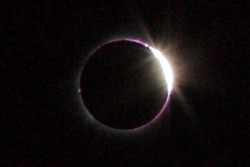 Diamond Ring, start of Totality | 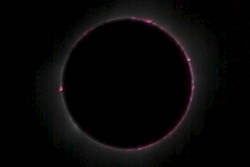 Prominences all around. |
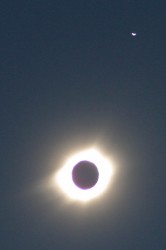 Corona and planet Venus | 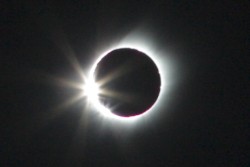 Double Diamond Ring |
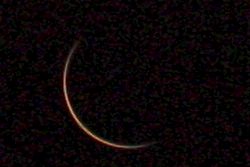 Crescent Sun | 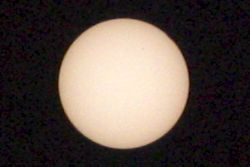 Eclipse almost over! |
Here are some shots from the all sky video camera:
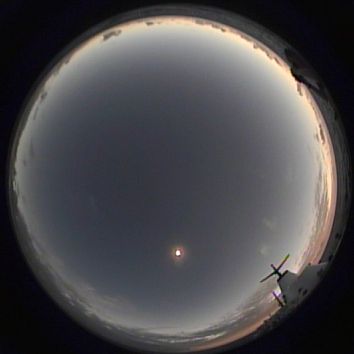
Second contact.
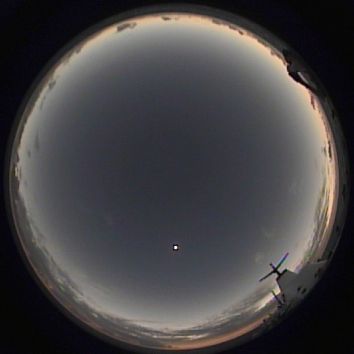
Mid eclipse.
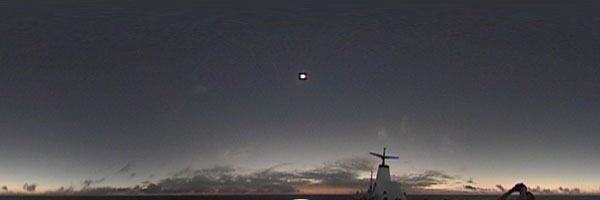
Mid eclipse, reprojected to panoramic format.
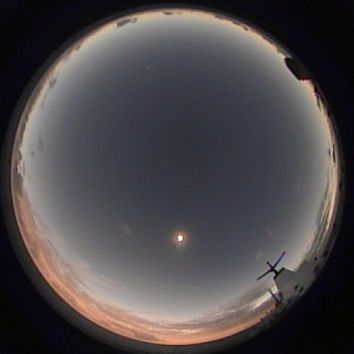
Third contact.
My G1 camera took a time lapse sequence of people near the pool:
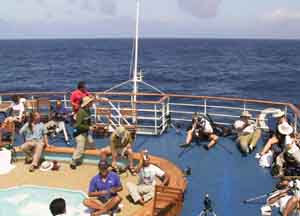
Just before totality.
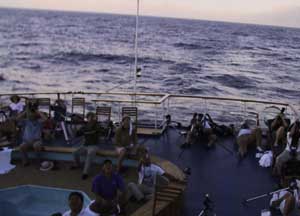
During totality.
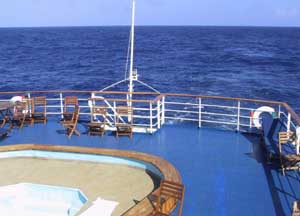
After fourth contact.
Because the G1 camera recorded the exposure settings for each image, I was able to reconstruct the ambient light intensity during the eclipse by plotting the camera's autoexposure selection over time. Light intensity measurements normally require a fancy and expensive light meter, so I was quite pleased with the results of this experiment. The formula is log2(Aperture^2/(Shutter*ISO)), and below is a plot showing how lighting was reduced by a factor of 1000x during the eclipse.
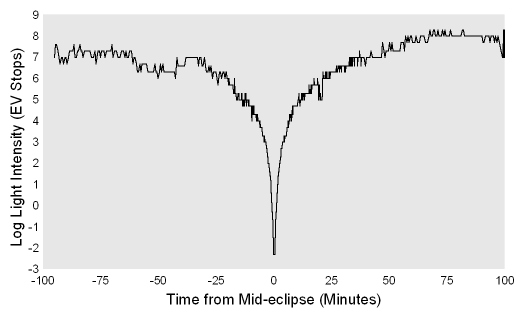
Below is the weather data I collected during the eclipse using my Kestrel 4000 weather meter. Our altitude didn't actually change; the slow rise in altitude is really a slow decrease in air pressure. The spread in altitude meaasurements is larger than the measurement noise, so the altimeter was detecting the rise and fall of the ship when it rolled with the swells!
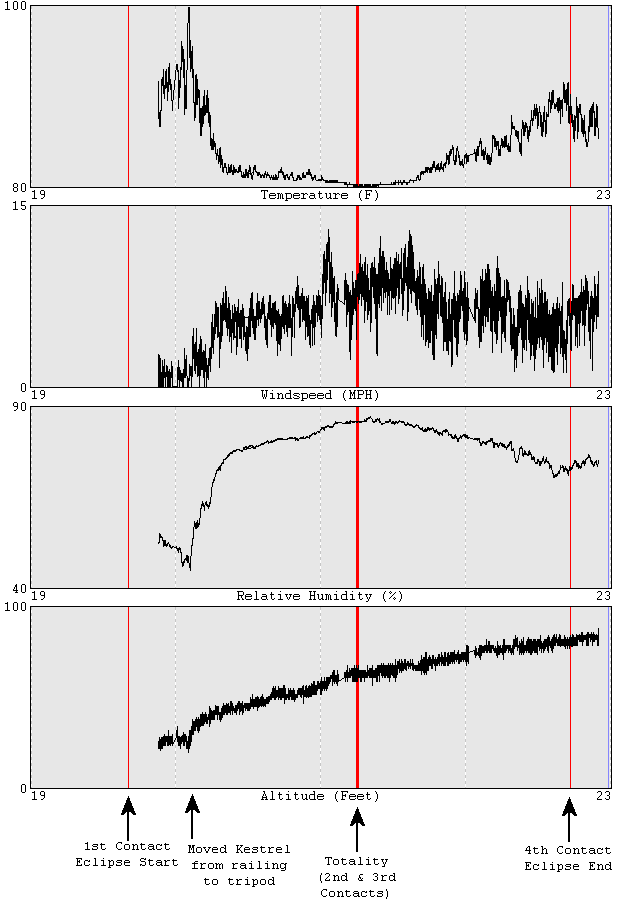
In the evening a cocktail party was held, and I wolfed down my dinner in order to make it outside in time to see the sunset:
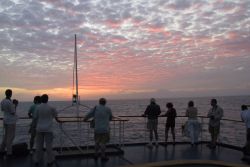
I spent the day reviewing my pictures and preparing the report posted above. I helped a number of people to process and/or upload their own pictures. In the evening the Captain invited me to his table for dinner, and I had a nice time chatting with him, his chief engineer Jimmy, and a half-dozen other guests.
It's been five days since we have seen any ship or airplane.
We saw two fishing boats today, some dolphins, and a whale. The day was capped by an amazingly colorful sunset.
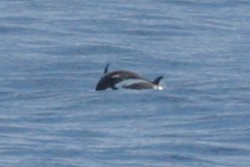 Dolphins. | 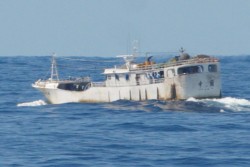 Fishing boat. |
 Sunset. | 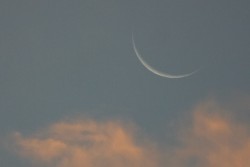 Crescent Moon. |
I spent some time today to scan the horizon with my binoculars. In every direction there was nothing but waves. Waves of every size and shape, from small ripples to massive swells that toss the ship. I cannot imagine how sailors of yesteryear and today cope with the isolation and monotony.
We've had an amazing array of special speakers covering everything from astronomy to eclipses to Darwin and the Galapagos. I've been busy almost the entire trip, and skipping a lecture feels like cutting class in college. Still, I've found the best way to pass the time is to crash onto my bed and sleep the hours away. I've never spent so much time sleeping, and we make jokes about how much exercise we get while sleeping because of the effort it takes to stay in bed - the ship has been in non-stop motion since leaving the Galapagos over a week ago.
The highlight of the day was 'Eclipse Show and Tell' where folks got up and shared their videos, photos, poetry, and stories of the eclipse and the trip so far. I played my time lapse video of the pool deck, and the all-sky video showing how close we came to being clouded out. Both seemed to be a big hit.
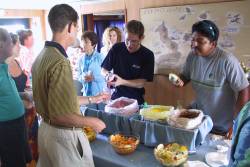 Ice Cream Festival. | 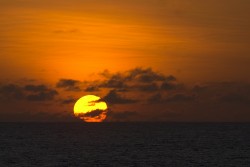 Sunset. |
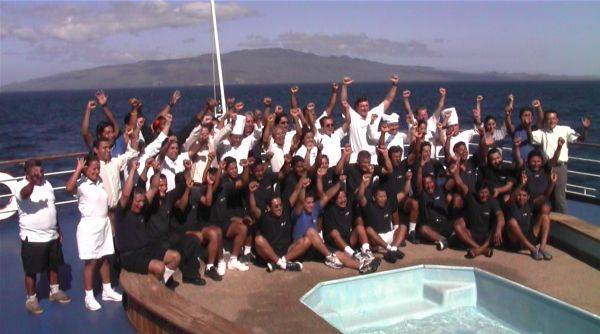
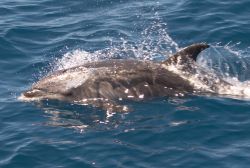 Dolphin. | 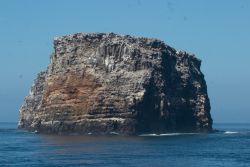 Round Rock. |
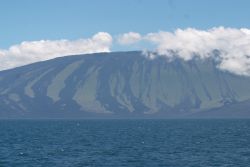 Volcano on Isabela island. | 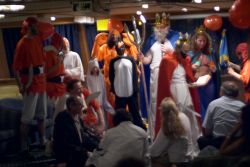 Neptune Party |
We are madly packing our belongings in time for tomorrow's 6 AM wakeup call, so today's update will be short. Beginning tomorrow I will be travelling and so updates may not happen every day.
We took a group photo today. I'm in the red shirt behind the guy in the alien shirt. Astronomy Magazine editor Dave Eicher is just to my right, somewhat obscured.
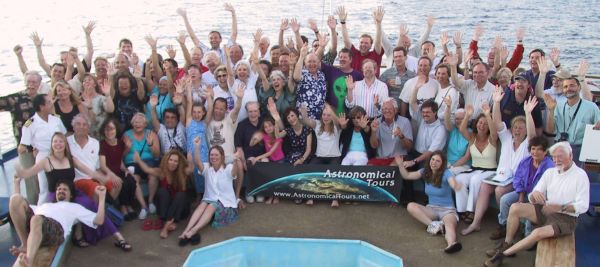
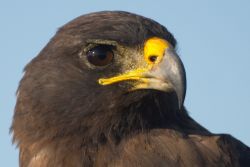 Galapagos Hawk. | 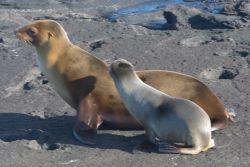 Sea lions. |
People then began to go their separate ways as the cruise was now over. After some normal confusion, I flew from Baltra in the Galapagos to Guayaquil, Ecuador, and then on to Quito. In the afternoon several of us took a tour to the equator, where I got my picture taken with one foot in the northern hemisphere and one foot in the southern, with GPS in hand to prove it. At the equator museum they did the standard Coriolis scam where they attempt to prove the location of the equator by draining a sink in various places. It was hilarious because it's a total sham scientifically, and they did it some 120 meters from the REAL equator!
In the evening Bob Shambora arranged a farewell dinner for about 25 of us. It was great to sit down together as a group one last time.
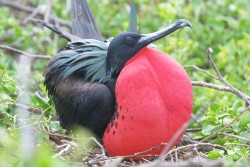 Frigate Bird on North Seymour. | 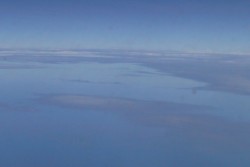 Can't tell where sea ends and sky begins. |
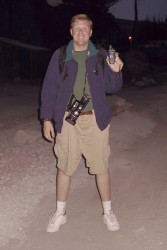 Straddling the equator. | 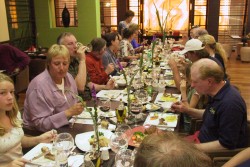 Farewell dinner. |
As I write this in the evening a cacophany of car horns is wafting into my hotel room. Ecuador has been in political turmoil the past few days as the general population has decided to stand up and fight the corruption and conflicts of interest in the government. The car horns are part of a citywide protest and have been honking nonstop for over two hours now and they will probably continue late into the night.
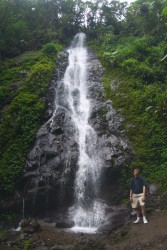 Tall waterfall. | 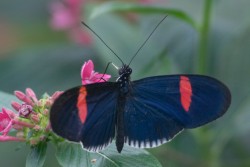 Butterfly. |
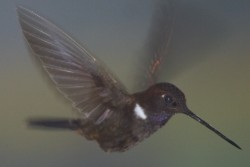 Hummingbird. | 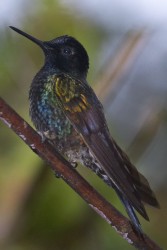 Hummingbird. |
I came home to about 900 emails, slightly over half of which are spam. It will take me a few days to reply to everyone who sent comments or questions.
My satellite phone bill was about double what I expected, but that's OK, it made the difference between seeing the eclipse and not seeing the eclipse!
This ends the daily updates. Please check back over the next few weeks, I'll be posting video of the eclipse and a much more detailed report.
Please visit my main astronomy page, or check out my homepage.
Comments? Questions? Click here to send email to me, Fred Bruenjes.
All text and images are © 2005 Manfred Bruenjes - All Rights Reserved. Image inlining (aka hot linking) and framing are strictly prohibited. Email for permission before using an image or text.